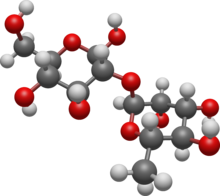
| |

| |
| Names | |
|---|---|
| IUPAC name α-L-Rhamnopyranosyl-(1→2)-D-glucose | |
| Systematic IUPAC name (2R,3S,4R,5R)-3,4,5,6-Tetrahydroxy-2-{oxy}hexanal | |
| Other names
2-O-alpha-L-Rhamnopyranosyl-D-glucopyranose 2-O-alpha-L-Rhamnosyl-D-glucose 2-O-(6-deoxy-alpha-L-mannopyranosyl)-beta-D-glucopyranose | |
| Identifiers | |
| CAS Number | |
| 3D model (JSmol) | |
| ChEBI | |
| ChEMBL | |
| ChemSpider | |
| ECHA InfoCard | 100.037.379 |
| KEGG | |
| PubChem CID | |
| CompTox Dashboard (EPA) | |
InChI
| |
SMILES
| |
| Properties | |
| Chemical formula | C12H22O10 |
| Molar mass | 326.29 g/mol |
| Density | 1.662 g/mL |
| Related compounds | |
| Related compounds | Rhamnose Glucose |
| Except where otherwise noted, data are given for materials in their standard state (at 25 °C , 100 kPa).
| |
Neohesperidose is the disaccharide which is present in some flavonoids. It can be found in species of Typha.
Neohesperidosides
- Cyanidin-3-neohesperidoside
- Delphinidin-3-neohesperidoside
- Rhoifolin or apigenin 7-O-neohesperidoside
- Myricetin-3-O-neohesperidoside found in Physalis angulata
- Neohesperidin (hesperetin 7-O-neohesperidoside)
- Neoeriocitrin (eriodictyol 7-O-neohesperidoside)
See also
References
- Horowitz, R. M.; Gentili, Bruno (January 1963). "Flavonoids of citrus—VI: The structure of neohesperidose". Tetrahedron. 19 (5): 773–782. doi:10.1016/S0040-4020(01)99211-7.
- ^ Andersen, Oyvind M. (1989). "Delphinidin-3-neohesperidoside and cyanidin-3- neohesperidoside from receptacles of Podocarpus species". Phytochemistry. 28 (2): 495–497. Bibcode:1989PChem..28..495A. doi:10.1016/0031-9422(89)80039-1.
- Ismail, N.; Alam, M. (2001). "A novel cytotoxic flavonoid glycoside from Physalis angulata". Fitoterapia. 72 (6): 676–679. doi:10.1016/S0367-326X(01)00281-7.
External links
This article about an organic compound is a stub. You can help Misplaced Pages by expanding it. |